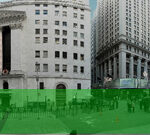As noted last week, construction of the Berlin Wall began in
August of 1961. In its completed stage, the Wall stretched 28
miles through the center of the city. There was also a “shadow”
wall which separated East Berliners from the main wall structure,
forcing potential escapees to break through two walls while
avoiding attack dogs, armed gunmen, and minefields. It”s
incredible to think that 30,000 heavily armed East German troops
stood guard from nearly 400 hundred positions.
The Berlin Wall didn”t come down overnight. The whole process
really began with the rise to power of Mikhail Gorbachev and his
new policies of perestroika and glasnost in the Soviet Union. As
Gorbachev wrote himself in his new book, “On My country and
the World,” “By the time discontent in East Germany had been
transformed into a mass movement, the people there knew that
my policy of ”freedom of choice” was not just a propaganda
slogan. They knew there would be no repeat of the events of the
Prague Spring in 1968, and that Warsaw Pact tanks would not
intervene. So they exercised their free choice by breaking down
the wall.”
By 1989, pressure for change mounted as East Germans fled the
German Democratic Republic (GDR) in record numbers. Many
traveled to the German Federal Republic (GFR) via
Czechoslovakia and then Hungary, whose government in May
had torn down the barbed wire stretching across the border with
Austria. About 150,000 East Germans reached the West during
the first nine months of 1989 alone.
Meanwhile, East German Chancellor Erich Honecker tried to
avoid the reforms undertaken by Gorbachev. He praised the
Chinese army and police for their crackdown in Tienenmen
Square in Beijing. And while other Communist regimes
negotiated with reformers, the East German leadership stood firm
until it was too late. Honecker kept up his tired slogans, “Always
forward with socialism, never back!” Hel-looo! He also stupidly
demanded that Hungary return fleeing East Germans to their
country, as specified in an old treaty between the two states. The
Hungarian government refused to do so.
When Gorbachev visited East Berlin early in October ”89,
demonstrators chanted his name, which had become synonymous
with opposition to the East German regime. When
demonstrations spread to other major cities, Honecker ordered
the police to attack the demonstrators, but Egon Krenz, the
Politboro member responsible for state security, refused to do so.
On October 18, Honecker, 77-years old, ill, and ignored, was
forced out in favor of Krenz.
Krenz was more moderate, but not a reformer. On October 23,
Soviet Foreign Minister Eduard Shevardnadze (currently the
heroic leader of Georgia) declared that each country in Eastern
Europe “has the right to an absolute, absolute freedom of
choice.” The demonstrators were further encouraged. Krenz
tried to keep up and on November 4, he announced that East
Germans were free to leave for West Germany via
Czechoslovakia. A wholesale exodus began.
On November 9, Krenz capitulated to the inevitable, announcing
a sweeping change in government and promising to initiate
legislation that would grant East Germans the right to travel
where and when they wanted. In addition, Krenz ordered that the
Berlin Wall be torn down. Within hours, almost 3 million East
Germans (out of a population of 16 million) poured through or
crossed into West Germany at once-forbidden checkpoints.
As author John Merriman notes, at the time an East German poet
said, “I must weep for joy that it happened so quickly and simply.
And I must weep for wrath that it took so abysmally long.”
Krenz hoped that the offer of free elections would save him but
the government fell on December 3rd. Elections were then held in
March, 1990.
Conservatives favoring German reunification won a surprisingly
easy victory over the remnants of the Social Democrat and
Communist parties. Previously, Gorbachev had announced no
opposition, though not without misgivings. Reunification was
previously unthinkable because of fear in Russia that one day
Germany might again threaten peace. Unification took place on
October 3, 1990. West German Chancellor Helmut Kohl stuck to
a tight timetable and in December, the first elections in the newly
unified Germany returned the Christian Democrats to power, with
Kohl as the new chancellor of Germany.
Who deserves the credit for the collapse of the Wall and the
reunification of Germany? Reagan? Gorbachev? There are some
others who deserve consideration. I was in Gdansk, Poland this
past spring. Surely Lech Walesa deserves credit for it was
Walesa with the emergence of his Solidarity Labor Union in
Gdansk that paved the way for other reformers throughout
Eastern Europe. In the November 8th issue of Newsweek, Walesa
had the following to say:
“The pope significantly accelerated the end of communism, and at
the same time he prevented bloodshed. He made people aware of
certain truths, made them feel their power. Someone else played
an important role – the journalists, especially the Western ones. If
they hadn”t publicized our struggle all over the world we
wouldn”t have had a chance. Ronald Reagan understood us the
way the journalists did. He understood that the end of
communism was imminent. He saw what was in his interest, and
he collaborated with us. So, I”d put the Holy Father in first place,
then the press, then Lech Walesa in third place, and then
Reagan.”
And from author David Fromkin, comes perhaps the best
explanation:
“The Berlin Wall – and other Soviet walls, both real and
metaphorical – came tumbling down because nobody believed in
them strongly enough to man them anymore. Not even the Soviet
elites, the prime beneficiaries of the collapsing system, were
disposed to call out the police or armed forces in defense of their
fiefdoms. The armed prophets, having lost faith in their religion,
surrendered their arms.” [Wall Street Journal, 11/9/99]
Sources: “A History of Modern Europe,” by John Merriman
“We Interrupt This Broadcast,” by Joe Garner
Brian Trumbore





